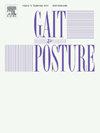Mechanisms of gait speed changes in middle-aged adults: Simultaneous analysis of magnitude and temporal effects
IF 2.2
3区 医学
Q3 NEUROSCIENCES
引用次数: 0
Abstract
Background
Middle-aged adults represent the transition between younger and older adults, where some of the characteristic gait differences due to aging begins to surface. However, the gait characteristics of middle-aged adults across the whole gait cycle remains an understudied topic. As speed is a sensitive indicator of health, characterizing the effects of speed on the gait of middle-aged adults and differentiating it from the response of young adults will provide insights into the effects of aging on gait speed modulation mechanisms.
Research question
What are the mechanisms of gait speed changes that are employed by middle-aged adults, and how are they different from younger adults?
Methods
A cohort of healthy young and middle-aged adults completed 60 second trials at three different speeds. Joint kinematics, kinetics, and surface electromyography data were analyzed and compared between the speed levels and age groups. Statistical Parametric Mapping along with a nonlinear curve registration algorithm was used to simultaneously assess the changes in both magnitude and timing of different metrics.
Results
When compared to the younger cohort, the middle-aged cohort had significantly lower ankle range of motion, dorsiflexion moment during loading response and plantarflexion moment during push-off. At the knee joint, the middle-aged adults had significantly lower knee flexion moment during stance. At the hip joint, the middle-aged adults had lower extension moment during terminal stance.
Significance
Time-continuous analysis showed that primary differences due to age were related to decreased joint range of motion and joint moment production capability in the middle-aged adults. Faster walking appears a safe method for middle-aged adults to increase joint range of motion and joint moment expression. However, targeted interventions that focus on improving capability are likely also needed. Suggested targets being improving ankle and knee joint moment capability, and increased range of motion at all joints.
中年人步速变化的机制:同时分析幅度和时间效应。
背景:中年人是年轻人和老年人之间的过渡阶段,在这一阶段,一些因衰老而产生的步态差异特征开始显现。然而,中年人在整个步态周期中的步态特征仍然是一个研究不足的课题。由于速度是衡量健康状况的一个敏感指标,研究速度对中年人步态的影响并将其与年轻人的反应区分开来,将有助于深入了解衰老对步态速度调节机制的影响:研究问题:中年人步速变化的机制是什么,与年轻人有何不同?一组健康的年轻人和中年人以三种不同的速度完成了 60 秒钟的试验。对关节运动学、运动学和表面肌电图数据进行分析,并在速度水平和年龄组之间进行比较。统计参数映射法和非线性曲线注册算法被用于同时评估不同指标的幅度和时间变化:结果:与年轻组相比,中年组的踝关节活动范围、加载反应时的背屈力矩和推起时的跖屈力矩明显较小。在膝关节,中年人在站立时的膝关节屈曲力矩明显较低。在髋关节,中年人在终站时的伸展力矩较低:时间连续分析表明,年龄造成的主要差异与中年人关节活动范围和关节力矩产生能力的下降有关。对于中年人来说,快走似乎是增加关节活动范围和关节力矩表达的一种安全方法。不过,可能还需要采取有针对性的干预措施,重点提高能力。建议的目标是提高踝关节和膝关节的力矩能力,并增加所有关节的活动范围。
本文章由计算机程序翻译,如有差异,请以英文原文为准。
求助全文
约1分钟内获得全文
求助全文
来源期刊

Gait & posture
医学-神经科学
CiteScore
4.70
自引率
12.50%
发文量
616
审稿时长
6 months
期刊介绍:
Gait & Posture is a vehicle for the publication of up-to-date basic and clinical research on all aspects of locomotion and balance.
The topics covered include: Techniques for the measurement of gait and posture, and the standardization of results presentation; Studies of normal and pathological gait; Treatment of gait and postural abnormalities; Biomechanical and theoretical approaches to gait and posture; Mathematical models of joint and muscle mechanics; Neurological and musculoskeletal function in gait and posture; The evolution of upright posture and bipedal locomotion; Adaptations of carrying loads, walking on uneven surfaces, climbing stairs etc; spinal biomechanics only if they are directly related to gait and/or posture and are of general interest to our readers; The effect of aging and development on gait and posture; Psychological and cultural aspects of gait; Patient education.
 求助内容:
求助内容: 应助结果提醒方式:
应助结果提醒方式:


